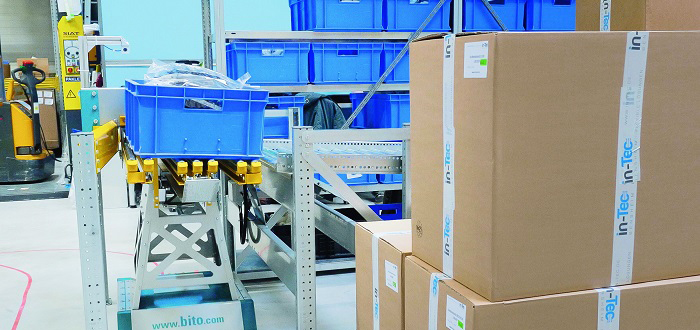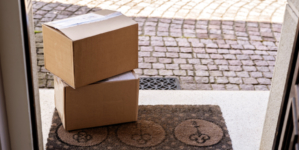-
BLACKOUT TECHNOLOGIES TARGETS TELEMATICS-INTEGRATED MOBILE DEVICE BLOCKING TO COMBAT SMARTPHONE DISTRACTION - 1 day ago
-
OpenADR Alliance announces first OpenADR 3.0 certified products with EVoke Systems, E.ON Energy and Universal Devices - March 25, 2025
-
Growing fulfilment and contract packer appoints new Managing Director - March 25, 2025
-
When is it time to invest in a WMS? Understanding the key trigger points - March 25, 2025
-
eCapital helps Vantage Recruitment on its journey to financial success - March 24, 2025
-
Hugo Beck Celebrates 70 Years of Packaging Innovation with Open House Events - March 20, 2025
-
PROLOG FULFILMENT SUPPORTS LUNA DAILY’S COMMITMENT TO BETTER BODY CARE FOR ALL WOMEN - March 19, 2025
-
Motion Ventures launches largest-ever maritime tech fund at $100M to meet the industry’s new pace of adoption - March 18, 2025
-
ITD GLOBAL APPOINTS GROUP CHIEF REVENUE OFFICER - March 17, 2025
-
SURECAM TEAMS UP WITH ENTERPRISE FLEX-E-RENT FOR VEHICLE REPAIR & MAINTENANCE CONFERENCE - March 14, 2025
Simple driverless transport for quick retail returns .
An online retailer’s profitability will stand or fall on having time- and cost-effective returns management. Edward Hutchison, Managing Director of BITO Storage Systems, explains how driverless transport systems can fulfil this need in online retail intralogistics operations.
A high volume of returns is a fundamental characteristic of e-commerce: the more goods are ordered over the Internet, the more returns will need to be processed.
Goods ordered online generally cannot be properly examined or tried on prior to purchase – driving online retail’s particularly high return rates. This is particularly the case In the fashion/accessories sector, but is also the experience of many other sectors such as automotive, consumer electronics and media where e-commerce businesses face the significant challenge of getting a grip on the exponential rise in the number of returns processed.
In other words, returns need to be received and sorted as quickly and efficiently as possible. Defective goods need to be separated out and either sent for repairs or disposed of. Other goods to be exchanged should be checked and then repacked and relabelled before being returned to the warehouse. In the field of e-fashion, for example, clothes often need to be ironed and/or hung up before they can be placed back in stock. The goal in every case must be to sort goods returned by the customer back into the warehouse as quickly as possible so that they can in turn be placed back on sale as soon as possible.
Time- and cost-effective returns management is crucial, because an online retailer’s profitability will stand or fall on this.
A driverless transport system can make processing returns simpler. Furthermore, by reducing travel times it can save time and money – even with the multi-level picking processes used in e-commerce warehouses and when traversing multi-tier installations.
Using the driverless transport system flexibly
Having a low-cost, simple yet effective and above all efficient returns processing pathway, will allow returned goods to be placed back on sale as quickly as possible. The driverless LEO Locative container transporter from BITO makes a smart addition to e-commerce warehouses. It helps to reduce travel times for returns and other tasks.
The transporter links workstations and handles transport from the returns department or processing point to other stations for repairs, disposal, ironing, packing or returning the item to the warehouse. Each destination can be flexibly programmed in as needed and integrated into the transporter’s journey.
Transport aids for multi-level picking
Multi-level picking is often a good choice for e-commerce businesses. Compared to single-level or single-item picking, multi-level picking combines multiple orders into a single ‘pick’, with items only later being packed as individual orders. Items are picked off the shelf individually. The use of a downstream sorting process or consolidation station enables picking to be freed to a very large extent from order-specific constraints. Multi-level picking is therefore seeing increasing use in the e-commerce sector, where a wide range of products are often sold.
LEO Locative also provides excellent assistance in this instance. The container transporter can drive to each picking station where it is loaded up by the picker, and then it carries the containers of orders to collection or packing stations before transferring them to the shipping department.
E-commerce businesses often use multi-tier installations for storage and picking. A good solution in such cases is having a LEO on each floor of the installation.
No Wi-Fi or IT required
Whether used in returns, for multi-level picking or on individual floors of a multi-tier e-commerce installation, the same is always true: with no Wi-Fi or IT required LEO Locative is easy to set up and run in-house – keeping procurement costs low. The user is always in charge of specifying routes and stopping points for this container transporter.
They can simply lay down an adhesive coloured line on the facility floor to mark the route for LEO to follow. Stations where the transporter needs to stop and any tasks this driverless system needs to perform at each location, are also specified using markers applied directly to the floor. These markers function as LEO’s ‘brain’ and contain the information the system needs to perform each task (such as stopping, handing over containers, receiving containers or proceeding onwards).
Now also with decentralised routing
Since it was first introduced to the market, the driverless LEO Locative transport system has proven itself as a container and carton transporter in practical use with numerous customers. Users across a wide range of industries are convinced by its ease of operation and its low cost. BITO presented a new innovation at LogiMAT 2018: a prototype for LEO Locative featuring decentralised routing.
Dennis Ramers, BITO Product Manager for LEO Locative, said: “Decentralised routing expands and complements our existing LEO Locative system. Until now, LEO has been able to follow fixed routes in a fixed order. This has made it the simplest ‘point-to-point transport system’ on the market – and it will continue to hold this title. But now, decentralised routing lets the user send the transport vehicle to different destinations using a simple interface on a tablet. This will open up many new applications for LEO Locative while preserving its key properties: simplicity, no need for Wi-Fi, centralised control and – as a result – low investment costs which pay off very quickly.”
Distributing goods
Decentralised routing offers significant benefits for returns processing in e-commerce. Returns are conventionally sorted into different categories at sorting stations, for example ‘Store’, ‘Iron’, ‘Wash’, and so on. LEO can now bring sorted items from sorting stations to the relevant departments. When returning items to the warehouse, the driverless container transporter can drive right up to the end of each aisle. Employees can then simply return goods to the rack ‘in passing’.
As with the original, the decentralised variant of LEO does not require any Wi-Fi or IT infrastructure. This makes it a standalone solution just like its centralised counterpart, allowing users to implement it in-house just as before. Decentralised routing systems can be retrofitted on previously delivered LEO Locatives if desired.
Visit our BITO YouTube channel for exciting videos and explanatory animations: https://www.youtube.com/user/bitomeisenheim. For more information and details of the complete system, as well as use cases and references, visit the LEO Locative website: www.leo-locative.com

































